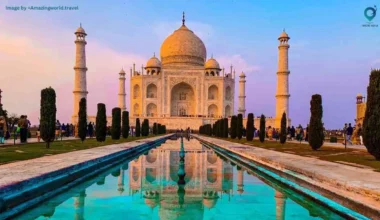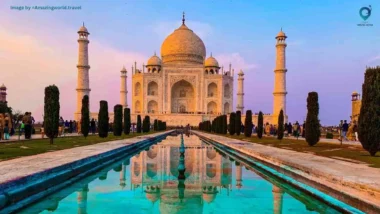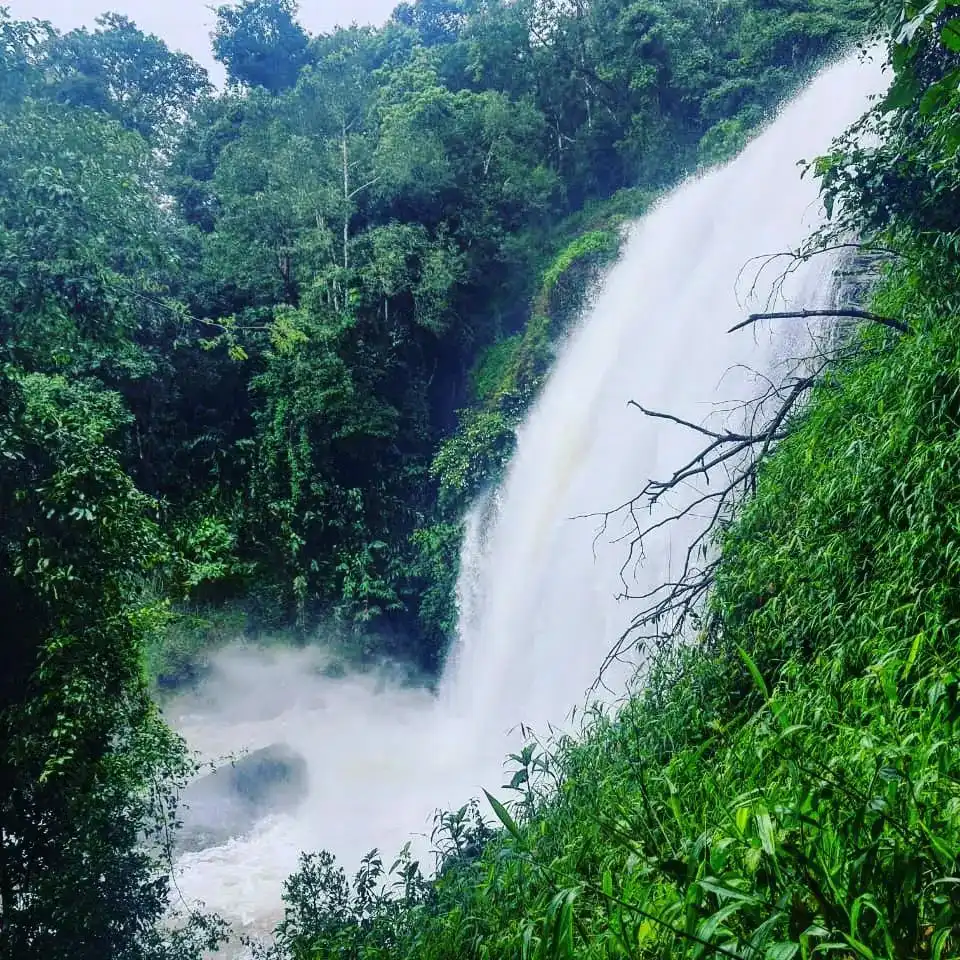In This Blogs
Introduction to Bhagwan Ram Mandir in Ayodhya: Exploring the Complete History and Architectural Insights
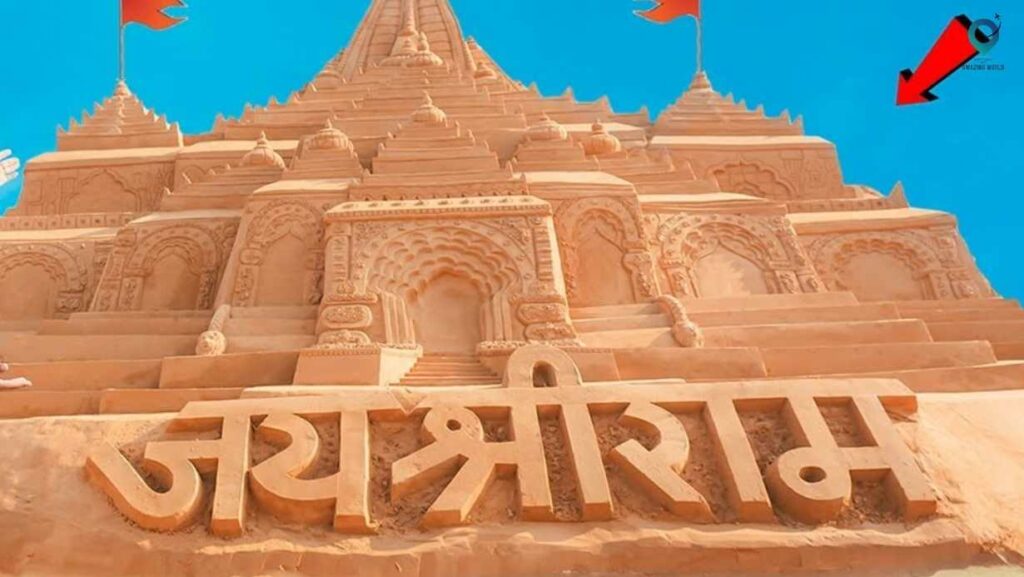
Ayodhya is known as Lord Ram’s birthplace and holds immense historical and religious importance in Hindu culture. It was the capital of the Kosala Kingdom and was ruled by King Dasaratha, Lord Ram’s father. The legends and teachings of Lord Ram in the ancient epic Ramayana have made Ayodhya a revered pilgrimage destination for millions of devotees seeking spiritual connections.
The Ram Mandir site has a rich history steeped in different eras. References to the shrine date back to ancient scriptures like the Brahmanda Purana and Garuda Purana, elevating Ayodhya as a sacred place in Hinduism. Over time, the temple underwent multiple renovations and reconstructions, blending various cultural and religious influences.
The Bhagwan Ram Mandir in Ayodhya is an architectural masterpiece, boasting intricate designs, splendid carvings, and grandeur showcasing ancient artisans’ skill. This multi-level temple, constructed with 392 pillars and 44 doors, follows the Nagara style. It features idols of Lord Ram, Goddess Sita, Lord Lakshman, and other revered deities from the Ramayana.
Beyond its architectural brilliance, the temple holds deep spiritual significance. Every architectural detail and sculpture within the temple premises tell a story from Lord Ram’s life, offering devotees a sacred space to connect with divine energy. Chants and prayers fill the temple, creating an atmosphere of devotion and tranquility.
Notably, the temple incorporates rare Shaligram stones found in Nepal’s Kali Gandaki River basin. These stones symbolize Lord Vishnu in Hindu beliefs. It’s reported that these unique stones will be used in crafting the idol of Lord Ram, enhancing the spiritual sanctity of the temple.
The Bhagwan Ram Mandir in Ayodhya is a symbol of reverence and devotion, drawing pilgrims worldwide. Its rich history, magnificent architecture, spiritual essence, and incorporation of special stones reinforce its significance as a cherished spiritual haven for Hindu devotees seeking a profound connection with Lord Ram.
“If you are looking for the best hotel and flight deals for your next vacation, then we recommend booking your bundled flight and hotel through hotwire.com.“
First Images of Ram Lalla Idol In Ayodhya Ram Mandir Unveiled
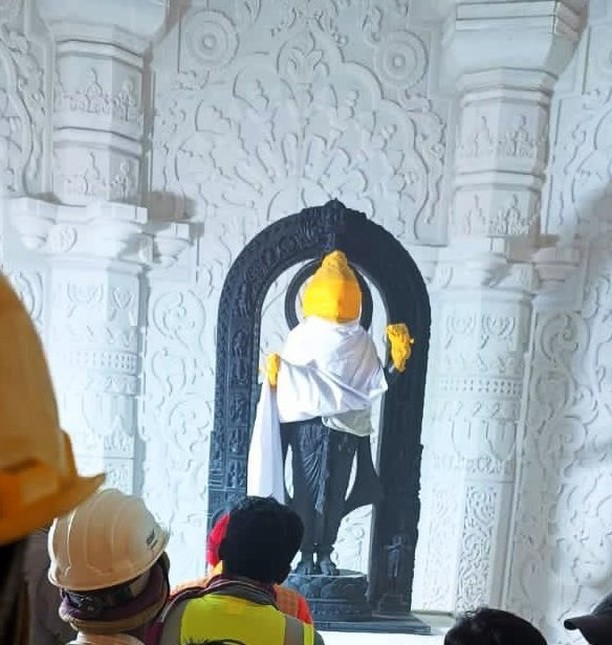
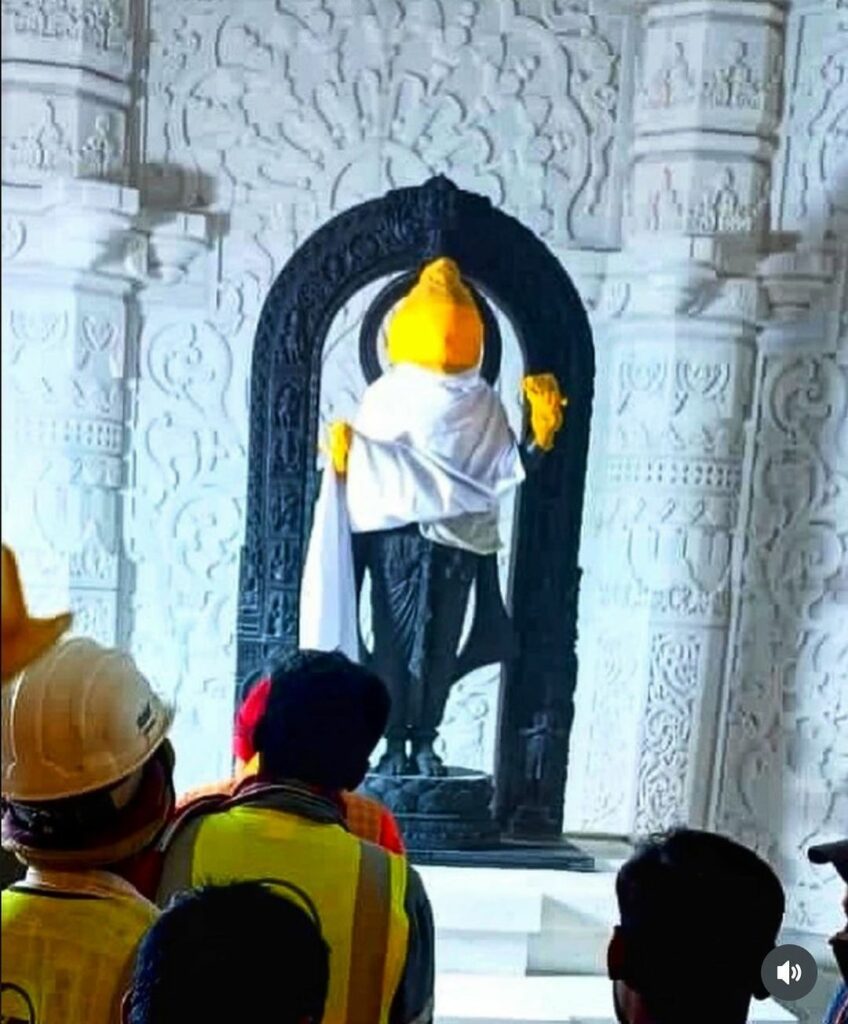
How to Reach Ayodhya for Bhagwan Sri Ram Mandir Darshan: from Different Nearby States.

Uttar Pradesh, Ayodhya has its own railway station, Ayodhya Dham (AYDH), well-connected to major cities like Lucknow, Varanasi, Allahabad, Kanpur, Delhi, etc. Trains like Ayodhya Cantt Express, Samjhauta Express, and Saryu Yamuna Express offer convenient options.
From Uttar Pradesh:
- From Lucknow: Ayodhya is approximately 143 kilometers from Lucknow. One can take a taxi or use public buses that regularly ply between these cities.
- From Varanasi: The distance between Varanasi and Ayodhya is around 220 kilometers. Travelers can opt for buses, taxis, or trains to reach Ayodhya from Varanasi.
From Bihar:
- From Patna: Patna to Ayodhya is approximately 386 kilometers. Travelers from trains or buses that connect these cities.
From Madhya Pradesh:
- From Bhopal: The distance between Bhopal and Ayodhya is approximately 790 kilometers. Travelers can use trains or buses to reach Ayodhya.
From Delhi:
- From New Delhi: Ayodhya is roughly 700 kilometers away from New Delhi. Travelers can opt for trains or buses that regularly operate between these two destinations.
By Air:
- Lucknow Airport (LKO): The closest airport to Ayodhya, 130 km away. Taxis and buses connect Lucknow to Ayodhya.
- Faizabad Airport (FZB): 60 km from Ayodhya, with fewer flight options compared to Lucknow.
By Road:
- National Highways: NH28, NH81, and NH244 connect Ayodhya to various states. Private buses, state roadways buses, and taxis are readily available from nearby cities.
Booking Procedure for Ram Mandir Darshan: Ticket Price & Vip Pass

Ticket Price Range: The ticket price for the Ram Mandir Darshan ranges between Rs 100 to Rs 300 per person. However, the Shri Ram Janmabhoomi Teerth Kshetra has not yet revealed the VIP pass price of the Darshan Ticket.
Different ticket categories may offer varied access or facilities within the temple premises.
Ticket booking Contact Info
- Helpline Number: 05278-292000,
- +91-80095-22111
To book tickets or gather accurate information about the temple and its darshan, visit the official government website at https://srjbtkshetra.org/.
Importance of 22nd January for Ram Mandir Opening Date: How to participate in the inauguration ceremony?
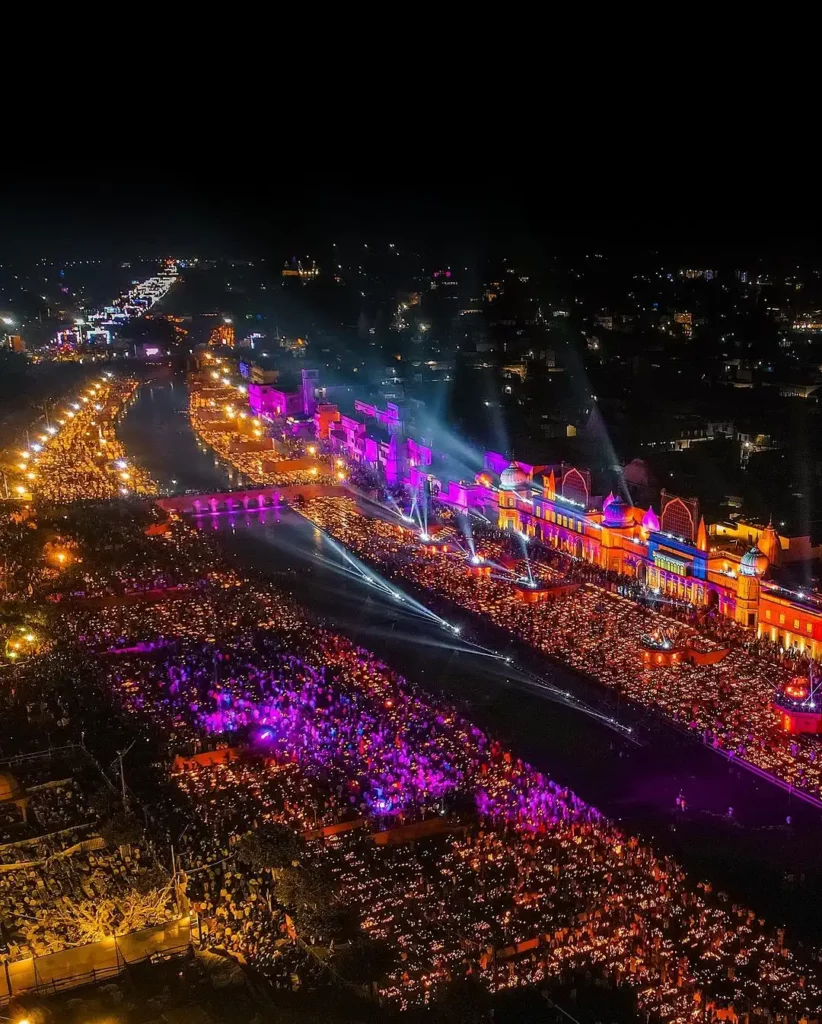


The 22nd of January, 2024, carries immense historical and astrological significance for the opening and inauguration ceremony of the Ayodhya Ram Mandir. It’s a confluence of factors that makes this date particularly auspicious for this momentous occasion.
Astrological Auspiciousness:
- The alignment of the Mrigashira Nakshatra on January 22nd further amplifies the ceremony’s auspiciousness. This Nakshatra, symbolized by a deer, represents the pursuit of knowledge and wisdom, fitting for the consecration of a temple dedicated to Lord Rama.
- Mrigashira, with Mars as its ruling planet, embodies activity and movement, reflecting the transformative energy surrounding the Ram Mandir’s opening.
- The Nakshatra’s positive influence extends from 3:52 am on January 22nd to 4.58 am on January 23rd, encompassing the core ceremonies.
Historical Significance:
- January 22nd marks the culmination of a decades-long movement for the construction of the Ram Mandir on the site believed to be Lord Rama’s birthplace. It signifies the fulfillment of a deeply cherished dream for millions of Hindus worldwide.
- The date coincides with Makar Sankranti, a major Hindu festival celebrating the sun’s entry into the Capricorn zodiac sign. This transition is seen as a new beginning, making it an ideal time for embarking on new ventures like the inauguration of the Ram Mandir.
Darshan and Aarti timings at the Bhagwan Shri Ram Mandir
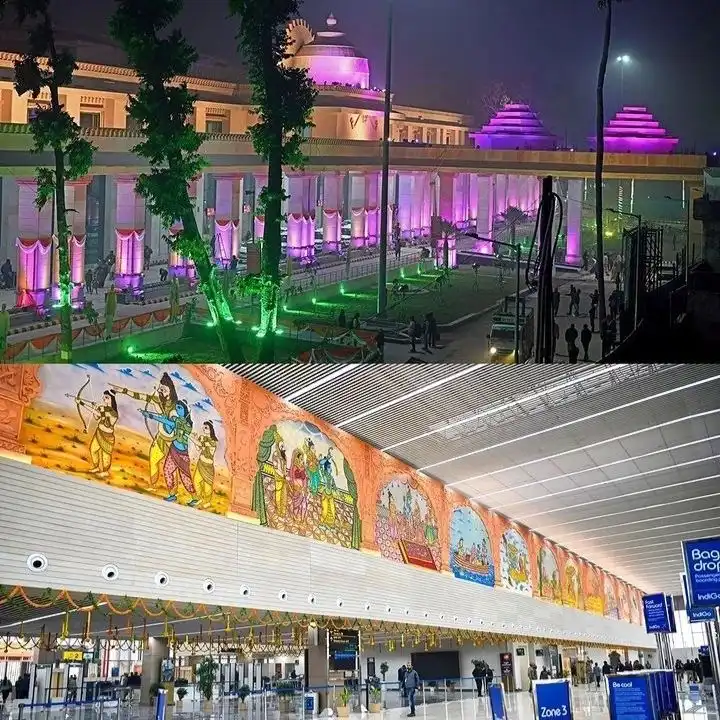
| Temple Darshan Timing | 7:00 AM – 11:30 AM, 2:00 PM – 7:00 PM |
| Aarti Timings | |
| Morning Jagran or Shringar Aarti | 6:30 AM |
| Afternoon Bhog Aarti | 12:30 PM |
| Evening Aarti | 7:30 PM |
| Aarti Booking Information | |
| Jagaran / Shringar Aarti | Booking is possible one day prior, subject to availability. Reach Camp Office with valid ID. |
| Sandhya Aarti | Same-day booking is possible subject to availability. Reach Camp Office with valid ID 30 mins before. |
Ayodhya and the Ram Mandir Photos: Cultural Importance for Hindus
Ayodhya, situated in the heart of India, holds immense cultural importance for Hindus worldwide. The significance of Ayodhya stems from its association as the birthplace of Lord Ram, a central figure in Hindu mythology revered as an incarnation of the divine. The city’s history intertwines with various religious scriptures, primarily the epic Ramayana, contributing to its profound cultural heritage.
For Hindus, Ayodhya is not just a geographical location but a spiritual realm where Lord Ram’s life and teachings unfolded. The Ramayana, an ancient Indian epic, narrates Lord Ram’s noble virtues, his adherence to righteousness, and his journey to fulfill his duties as a prince, husband, and ruler.
The Ram Mandir, symbolizing Lord Ram’s birthplace, stands as a testament to this cultural legacy. The temple’s construction holds deep-rooted cultural and emotional significance for Hindus, marking the restoration of their sacred site. It signifies the embodiment of faith, devotion, and the triumph of righteousness over adversity.
Hindus revere Ayodhya and the Ram Mandir as a symbols of unity, faith, and reverence. It’s a cultural beacon that unites people through shared beliefs, rituals, and devotion to Lord Ram. Pilgrims from across the globe visit Ayodhya to pay homage, seek blessings, and immerse themselves in the spiritual aura of this ancient city.
What to Expect at Ram Mandir, Ayodhya: Visitor’s Experience & Highlights
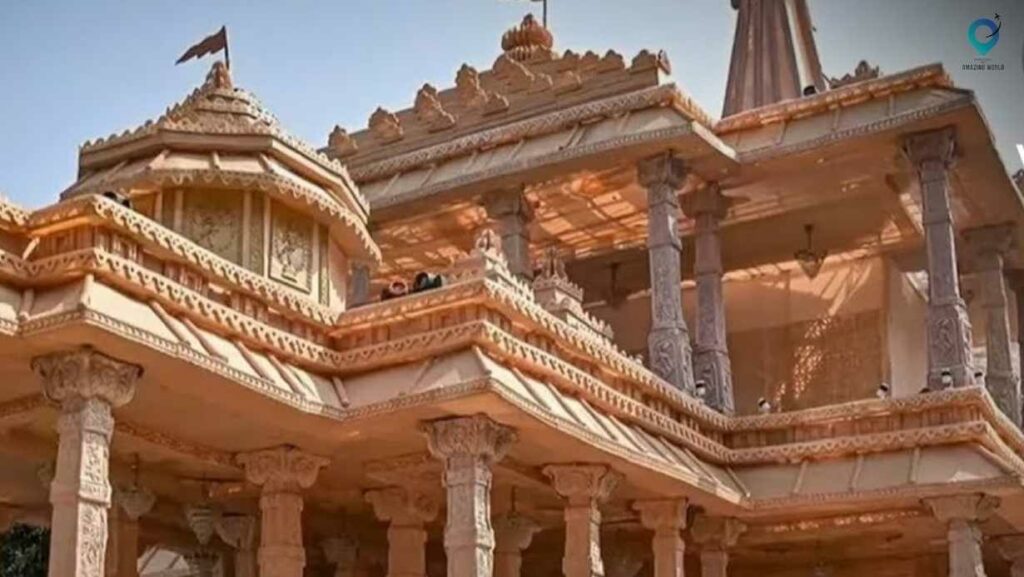
When planning a visit to the Ram Mandir in Ayodhya, visitors can anticipate a spiritually enriching and culturally immersive experience. Here’s what to expect and the highlights of the visit:
- Spiritual Atmosphere: The temple complex emanates a serene and spiritually charged environment, with devotees offering prayers and chanting hymns in devotion to Lord Ram. The ambiance is filled with the resonating sounds of religious chants and bells, creating a tranquil setting for introspection and worship.
- Architectural Marvel: Witness the breathtaking architectural beauty of the Ram Mandir. Marvel at the intricate carvings, sculptures, and ornate designs that adorn the temple’s exterior and interiors. The sanctum sanctorum houses the idols of Lord Ram, Goddess Sita, and Lord Lakshman, inviting devotees to seek blessings and find solace.
- Cultural Insights: Explore the rich cultural heritage of Ayodhya, intricately linked with the Ramayana. Various shrines within the temple complex dedicated to different characters from the epic offer insight into the legends and stories associated with Lord Ram’s life.
- Cultural Significance: Engage with the profound cultural significance of Ayodhya and the Ram Mandir. Immerse yourself in the traditions, beliefs, and stories that have been passed down through generations, discovering the deep-rooted cultural fabric of Hinduism.
- Peaceful Reflection: Amidst the hustle-bustle, find moments of tranquility by the Saryu River Ghat or within the temple complex. These serene spaces provide an ideal setting for quiet introspection and meditation.
- Cultural Exchange: Engage in cultural exchanges with fellow devotees and pilgrims from different regions, witnessing how faith unites people from diverse backgrounds in a shared spiritual journey.
Visiting the Ram Mandir in Ayodhya promises not just a spiritual pilgrimage but an immersive cultural experience, offering insights into Hindu traditions, values, and the timeless saga of Lord Ram.
Choosing the Best Entry for Ram Mandir, Ayodhya: Visitor’s Guide

Selecting the best entry for the Ram Mandir in Ayodhya involves considering various factors that can enhance your overall experience. Here’s a visitor’s guide to help you make an informed decision:
- Regular Entry: This is the standard entry accessible to all visitors. It usually involves queuing and may have longer waiting times, especially during peak hours or auspicious days. It’s the most common and readily available entry option.
- VIP or Fast Track Entry: Some temples offer a VIP or fast track entry, usually at a higher fee. This entry allows visitors to bypass longer lines, saving time and providing a quicker route to the main sanctum.
- Special Entry for Devotees: Some temples have a separate entry for devotees or worshippers, allowing them direct access to perform rituals or offer prayers without waiting in long queues.
- Group Entry or Tour Packages: Tour groups or agencies may provide special group entries with guided tours. These packages often include additional amenities, explanations, or curated experiences.
Factors to Consider:
- Time: If you have limited time or wish to avoid queues, the VIP or fast track entry might be preferable. However, regular entry may offer a more immersive experience.
- Comfort: Consider your comfort level. If you prefer a more relaxed pace or enjoy observing the surroundings, regular entry might suit you better.
- Spiritual Significance: Some visitors prefer special entry options to ensure they can perform specific rituals or prayers without interruptions.
- Budget: Different entries may have varying costs. VIP or special entries typically come at a higher price, so factor in your budget when deciding.
- Peak Seasons: During festivals or auspicious days, regular entries might experience longer wait times. In such cases, special or fast track entries could be more beneficial.
Before choosing an entry option, it’s advisable to check with the temple authorities or on their official website for updated information on entry timings, availability, and any specific requirements. Assessing your priorities and preferences will help you decide the best entry option to make your visit to the Ram Mandir in Ayodhya a memorable and fulfilling experience.
Activities and Things to Do at Ram Mandir, Ayodhya: Visitor’s Checklist
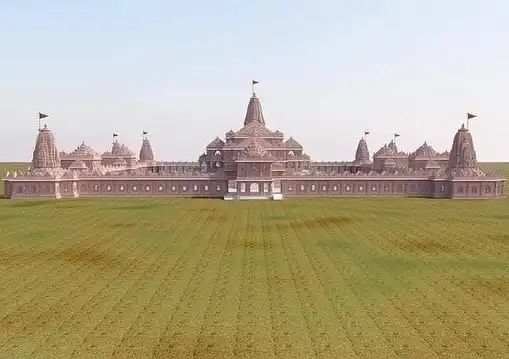


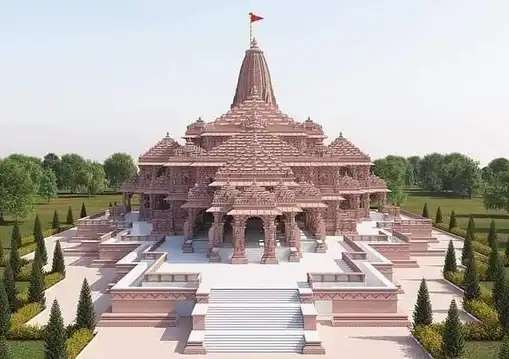
When visiting the Ram Mandir in Ayodhya, there are various activities and essential things you might consider for a fulfilling and memorable experience. Here’s a visitor’s checklist:
- Exploring the Temple Complex: Take your time to explore the entire temple complex, admiring the architecture, intricate carvings, and religious significance of the various sections and shrines.
- Participate in Aarti: Engage in the temple’s Aarti ceremonies to witness and be a part of the devotional rituals. Timings for Aarti are crucial and provide a spiritual connection to the deity.
- Offering Prayers: Pay homage and offer prayers to Lord Ram, Goddess Sita, Lord Lakshman, and other deities present in the temple complex.
- Sightseeing in Ayodhya: Apart from the Ram Mandir, explore other significant sites in Ayodhya associated with Hindu mythology, such as Saryu River Ghat, Hanuman Garhi, Kanak Bhavan, and more.
- Attend Religious Ceremonies: Depending on the time of your visit, you might have the opportunity to witness specific religious ceremonies or festivals.
- Learn the History: Engage with the guides or read about the historical and mythological significance of Ayodhya and the Ram Mandir to deepen your understanding.
- Capture Moments: Take photographs of the temple complex and the scenic beauty around Ayodhya to create lasting memories of your visit.
- Dress Code: Ensure you are dressed modestly and respectfully, adhering to the temple’s dress code guidelines.
- Respect Local Customs: Show respect for local customs and traditions, following temple rules and guidelines, and being mindful of other visitors’ sentiments.
- Shopping for Souvenirs: Explore nearby markets for souvenirs or religious items that hold significance in Hindu culture as mementos of your visit.
- Try Local Cuisine: Experience the local vegetarian cuisine of Ayodhya, known for its traditional flavors and specialties.
- Plan According to Timings: Consider the temple’s opening and closing hours while planning your visit to ensure you have ample time to explore.
Remember to check the temple’s official website or contact authorities beforehand to confirm any specific regulations, timings, or additional activities available during your visit. Following these pointers can help you make the most of your visit to the Ram Mandir in Ayodhya and its surrounding areas.
Preparing for the Trip to Ayodhya: 3-Day Full Itinerary Guide
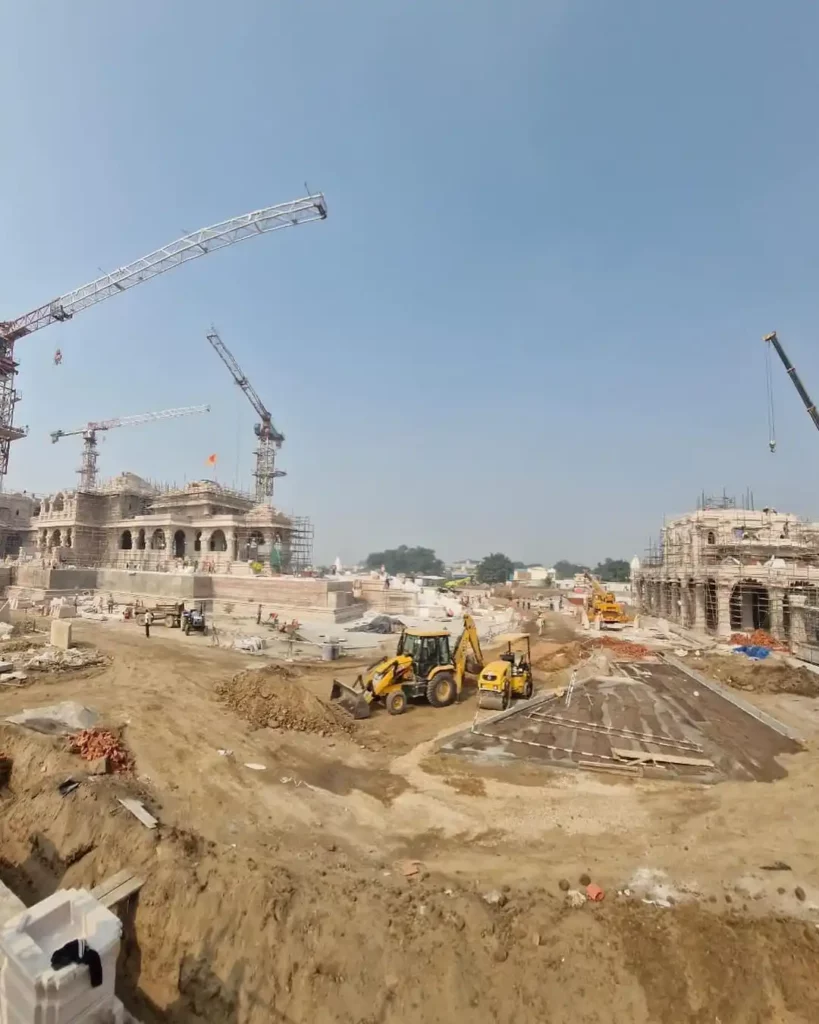
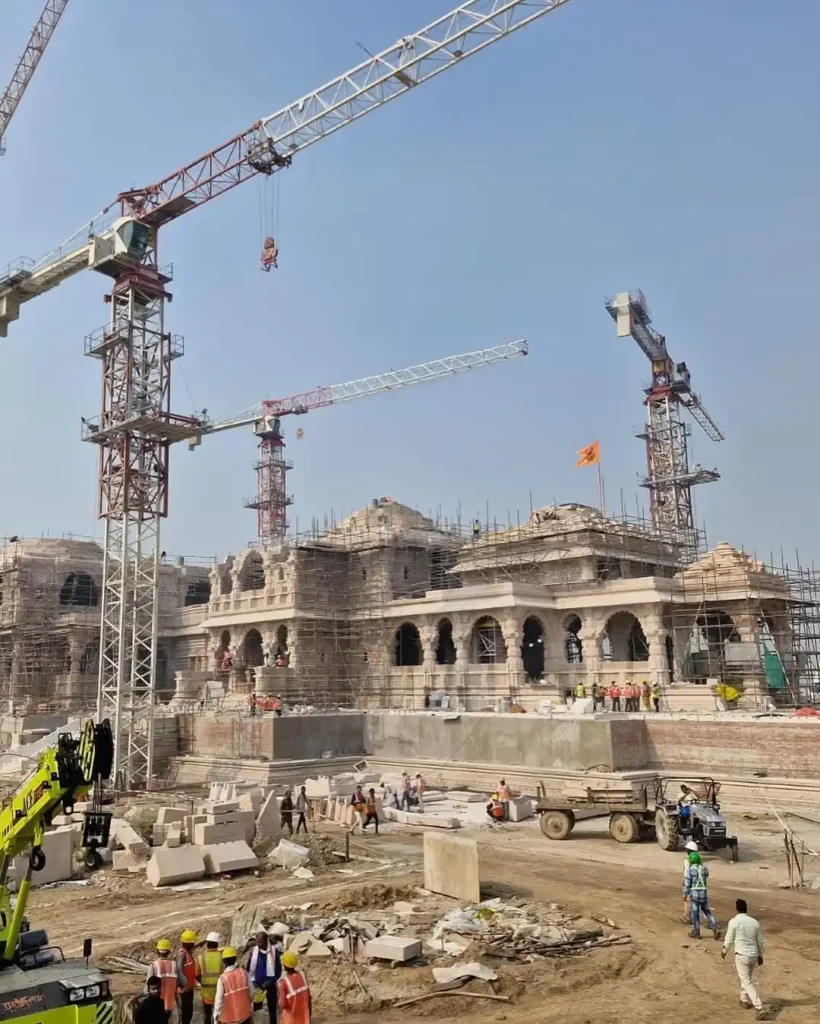
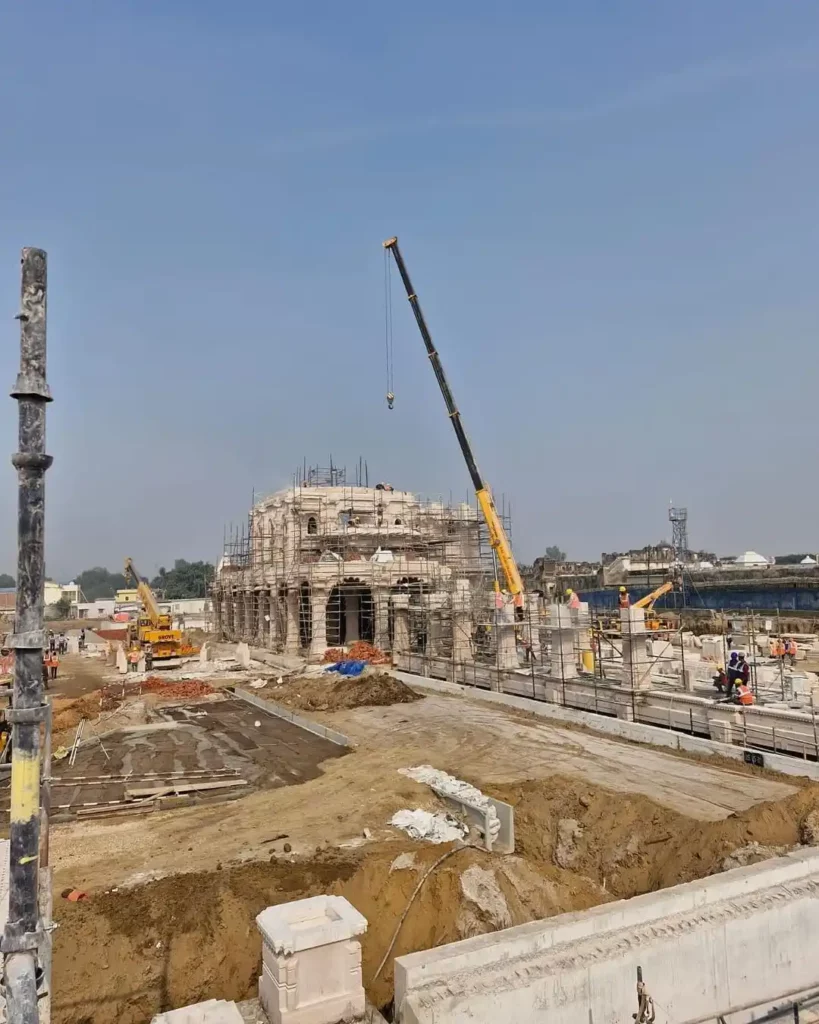
Day 1: Arrival and Temple Exploration
Morning:
- Arrival in Ayodhya: Reach Ayodhya via your chosen mode of transportation – flight, train, or road.
- Check-in: Check-in to your pre-booked accommodation near the temple area.
- Freshen Up and Breakfast: Freshen up and enjoy a hearty breakfast to kickstart your day.
Afternoon:
- Visit to Ram Mandir: Head to the Ram Mandir complex and explore the temple architecture, shrines, and religious significance.
- Attend Aarti: If arriving in time, attend the evening Aarti for a spiritual experience.
Evening:
- Dinner: Savor a delightful dinner at a local restaurant, experiencing the flavors of Ayodhya.
Day 2: Exploring Ayodhya’s Cultural Heritage
Morning:
- Breakfast: Start your day with a delicious breakfast at your accommodation or a local eatery.
- Sightseeing: Visit Hanuman Garhi, Kanak Bhavan, Saryu River Ghat, and other prominent sites associated with Hindu mythology.
Afternoon:
- Lunch: Enjoy a traditional lunch with Ayodhya’s local cuisine.
Evening:
- Leisure Time: Spend the evening exploring local markets, shopping for souvenirs, or relaxing by the Saryu River.
- Dinner: Relish another round of local delicacies for dinner.
Day 3: Immersive Experience and Departure
Morning:
- Morning Aarti or Darshan: Attend the morning Aarti or utilize this time for another Darshan at the temple.
- Breakfast: Have breakfast and prepare for departure.
Afternoon:
- Check-out: Check-out from your accommodation.
- Last-minute Sightseeing: If time permits, visit any sites missed or take a final stroll around the town.
Evening:
- Departure: Depart from Ayodhya with enriching memories and spiritual experiences.
Tips:
- Prioritization: Prioritize temple visits during timings with fewer crowds for a serene experience.
- Booking Passes: If required, book Aarti passes in advance for smoother access.
- Respect Local Customs: Respect local customs and dress modestly while visiting religious sites.
- Transportation: Plan transportation for easy commutes between sites.
- Local Guides: Consider hiring local guides for insightful information and stories about the sites.
This itinerary provides a balanced mix of spiritual exploration, sightseeing, cultural experiences, and leisure time, ensuring a memorable and fulfilling trip to Ayodhya and the Ram Mandir. Adjustments can be made based on personal preferences and specific interests.
Budget-Friendly and Luxury Hotels in Ayodhya: Accommodation Guide
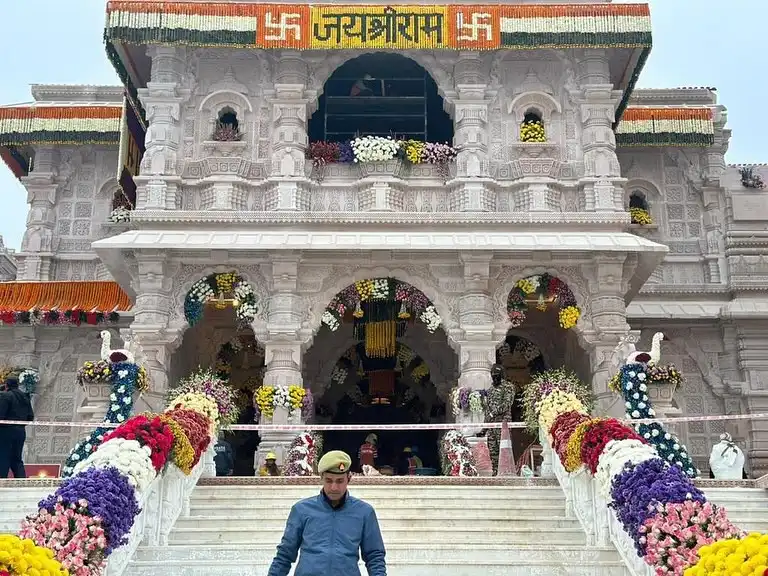
| Sl. No. | Hotel Name | Address | Contact Number |
| 1 | Royal Heritage Hotel | NH.27 Near Saryu Bridge Ayodhya | 81888290901, 8188829091 |
| 2 | Bedi’s Dream Land | NH.27 Near Saryu Bridge Ayodhya | 8400334035 |
| 3 | Awadh Sunshine Palace | NH.27 Near Saryu Bridge Ayodhya | 9151547575, 9151557547 |
| 4 | Surya Palace | Bhaunumati Road, Near Ayodhya Bypass | 9838771777 |
| 5 | Hotel Ramayana | Near Booth no -4 Shanwajpur Manjha Darshan Nagar Ayodhya -224135 | 6386902021 |
| 6 | Taraji resort | Opposite saket puri yojna,deokali byepass churaha,Nh 27 ayodhya | 710100095, 7311160000 |
| 7 | Hotel Panchsheel | Near Devkali Bypass Crossing, NH 28 Ayodhya | 7706829463 |
| 8 | Shane avadh | Civil Lines Ayodhya | 9455096925 |
| 9 | Tirupati | Civil Line Faizabad 001, Ayodhya | 9453500000 |
| 10 | Krishna palace | 1/13/357, Civil Lines Ayodhya | 8874210002 |
| 11 | Krinoscco | Amaniganj Faizabad, Ayodhya Road 60 | 7275092525, |
| 12 | Ramprastha | Nayaghat Ayodhya | 8115000098 |
| 13 | Rameshwaram palace | Pump-Nayaghat Road Ayodhya | 8957770208 |
| 14 | Ramila kutir | 49/2/1-A Ramghat Halt Crossing Ram Ki Paidi Nayaghat Ayodhya 224123 | 9792441555 |
| 15 | Raghunandan inn | 6/4/192A, Madrahiya Parikarma Marg Halkara Ka Purwa Ayodhya | 7706899864, 9793000000 |
| 16 | Hotel Jivan sathi Lawn | NH-28 Nikat Priya Battery – Deokali Bye Pass | 9118395555 |
| 17 | Royal hotel | Ramghat Churaha Near Manas Bhawan | 9451270266 |
| 18 | Tanwi palace | Ramghat Churaha Near Manas Bhawan | 7052906666 |
| 19 | Manas Bhawan | Ramghat Churaha, Ayodhya, Uttar Pradesh 224123 | 7398206100 |
| 20 | R.G hotel | 2/4/1, Madrahiya Aranya Puram Parikarma Marg, Halkara Ka Purwa Ayodhya | 8840037362, 9696800000 |
Local Food in Ayodhya: Culinary Experience
| Local Foods in Ayodhya | Taste |
| 1. Aloo Tikki | Spiced mashed potato patties topped with chutney and yogurt. |
| 2. Pani Puri | Hollow crispy puris filled with tangy flavored water and condiments. |
| 3. Kachori | Deep-fried dumplings filled with spiced lentils or potatoes. |
| 4. Samosa | Triangular pastries filled with spiced potatoes and peas, deep-fried until golden. |
| 5. Papri Chaat | Crispy fried dough wafers topped with yogurt, chutney, and spices. |
| 6. Jalebi | Circular-shaped deep-fried batter soaked in sugar syrup, crispy and sweet. |
| 7. Gulab Jamun | Deep-fried milk-solid balls soaked in sugar syrup, a rich dessert. |
| 8. Dal Poori | Fried bread stuffed with lentils, aromatic and fulfilling. |
| 9. Malpua | Sweet pancake-like dessert often served with flavored syrup or rabri. |
| 10. Thandai | Refreshing milk-based drink with nuts and spices, popular during festivals. |
| 11. Lassi | Traditional yogurt-based drink available in various flavors – plain, sweet, or flavored. |
| 12. Baingan Bharta | Smoky mashed eggplant cooked with spices and herbs. |
| 13. Paneer Dishes | Cottage cheese cooked in different styles – gravy, tikka, or dry. |
| 14. Tandoori Roti | Oven-baked flatbread with a smoky flavor. |
| 15. Butter Naan | Soft leavened bread brushed with butter, a perfect accompaniment. |
| 16. Dahi Vada | Lentil dumplings soaked in yogurt, topped with chutney and spices. |
Dress Code for Ram Mandir Darshan: Attire Recommendations
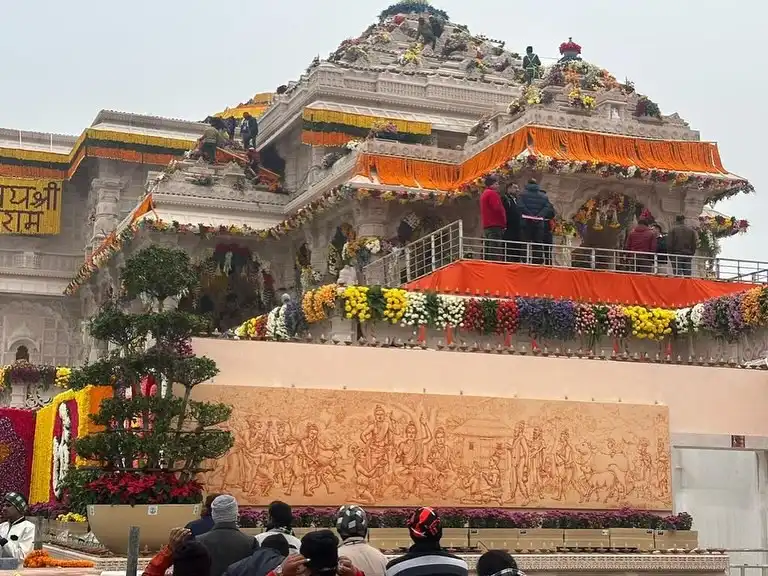
Men:
- Traditional Wear: Kurta-Pajama, Dhoti-Kurta, Sherwani, or Traditional Ethnic Wear.
- Full-Length Pants: If not wearing traditional attire, full-length pants with a decent shirt are acceptable.
- Avoid Shorts: It’s advisable to avoid wearing shorts or revealing clothing out of respect for the sacred place.
Women:
- Sarees or Salwar Kameez: Traditional Indian attire like sarees or salwar suits.
- Long Skirts/Dresses: If not wearing traditional attire, long skirts or dresses covering the knees are acceptable.
- Modest Clothing: Clothing that covers shoulders and avoids revealing cleavage is recommended.
- Avoid Tight or Short Outfits: Clothing that is too tight or too short should be avoided out of respect for the religious sanctity.
Footwear:
- Footwear Regulations: Some temples might require you to remove footwear before entering the temple premises. Consider comfortable footwear that is easy to slip on and off.
General Guidelines:
- Modesty is Key: The recommended attire focuses on modesty and respect for the religious and spiritual environment.
- Comfortable Wear: Wear comfortable clothing considering the climate and walking around the temple complex.
- Weather Consideration: Layer clothing or carry a shawl if visiting during colder months.
- Head Covering (Optional): Some individuals choose to cover their heads out of reverence, but it’s not mandatory in all temples.
Respecting the dress code guidelines not only showcases cultural sensitivity but also allows for a more respectful and comfortable visit to the Ram Mandir.
Nearby Tourist Attractions in Ayodhya: Other Points of Interest
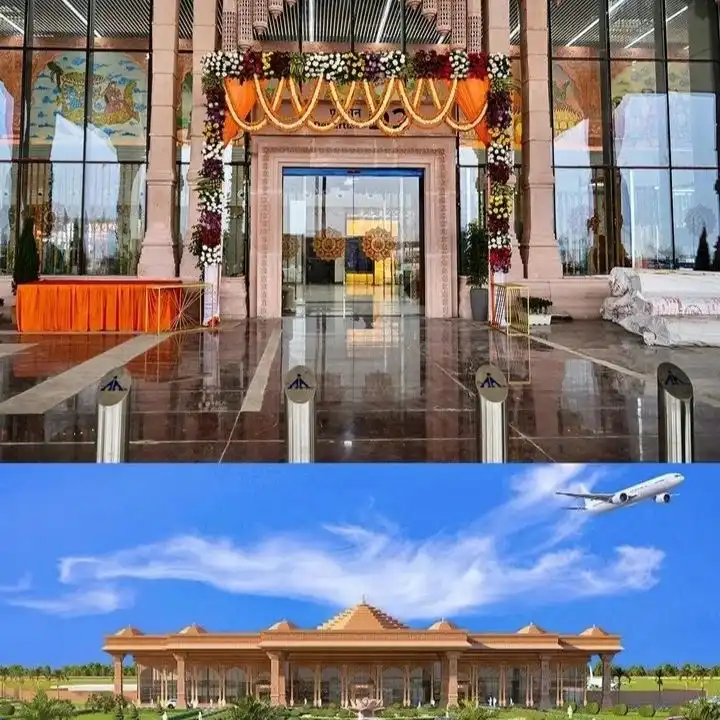
- Sita Ki Rasoi: A historical site associated with Goddess Sita; it’s believed to be her kitchen.
- Kanak Bhawan: A sacred temple known for the idols of Lord Ram and Goddess Sita adorned in gold.
- Hanuman Garhi: A prominent temple dedicated to Lord Hanuman, offering a panoramic view of Ayodhya.
- Treta Ke Thakur: A temple dedicated to Lord Ram’s sandals and ancient deities.
- Guptar Ghat: A revered site where Lord Ram is said to have taken a dip in the Saryu River.
- Tulsi Smarak Bhawan: A museum dedicated to Goswami Tulsidas, the saint-poet who wrote the Ramcharitmanas.
- Lakshman Ghat: A significant site where Lord Lakshman is believed to have taken a bath.
- Dashrath Mahal: A historical monument dedicated to King Dashrath, Lord Ram’s father.
- Gulab Bari: A beautiful garden complex housing the tombs of Nawabs of Ayodhya.
- Nageshwarnath Temple: An ancient temple dedicated to Lord Shiva, visited by devotees.
Tips and Recommendations for Visiting Ayodhya: Essential Advice
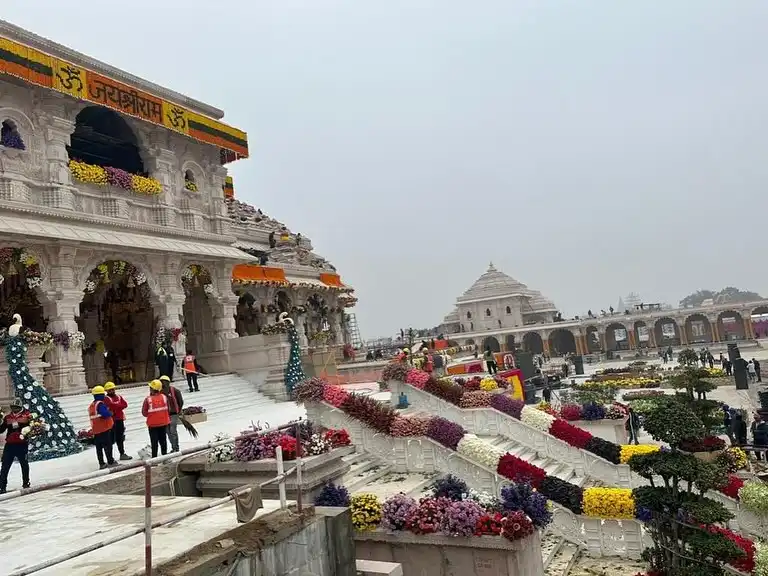
- Respect Local Customs: Ayodhya is a religiously significant place. Respect local traditions, customs, and religious sentiments.
- Footwear: While visiting temples and religious sites, it’s customary to remove footwear before entering. Carry a bag to store your shoes conveniently.
- Dress Modestly: Wear modest and conservative clothing, especially while visiting religious sites. It’s recommended to avoid shorts and sleeveless tops.
- Permitting Photography: Some places might not permit photography or have restricted areas. Respect these guidelines.
- Maintain Silence: Temples and sacred areas often require a serene atmosphere. Maintain a quiet demeanor to respect the spiritual ambiance.
- Travel and Accommodation: Book accommodations in advance due to high demand during festivals or significant events. Make travel arrangements early, especially during peak seasons.
- Safety Measures: Be cautious with your belongings and valuables. Follow safety guidelines, especially in crowded areas.
- Local Cuisine: Explore Ayodhya’s local vegetarian cuisine, known for its flavors and variety. Try local delicacies but ensure it aligns with your dietary preferences.
- Weather Consideration: Ayodhya experiences varying temperatures; carry appropriate clothing depending on the season of your visit.
- Local Guides: Consider hiring local guides for detailed insights into historical and religious significance.
Conclusion.
A visit to Ayodhya, especially to the revered Ram Mandir, offers a profound spiritual and cultural experience. The city, deeply intertwined with Hindu mythology and history, holds immense significance as the birthplace of Lord Ram.
From exploring the rich history and architectural brilliance of the Ram Mandir to savoring the local cuisine and embracing the spiritual ambiance, Ayodhya offers a transformative journey. The city’s cultural heritage, traditional values, and religious importance make it a must-visit destination for devotees and travelers seeking spiritual enlightenment.
As you plan your trip, remember to respect local customs, dress modestly, and immerse yourself in the serenity of the sacred sites. Be prepared for an enriching experience that connects you with the divine and leaves a lasting impact on your spiritual journey.
How much did you like Our Detailed Ram Mandir, Ayodhya: 2024 Guide – Tickets, how to visit, Stay: Your Ultimate Guide? Review Also, please share these Blogs with your friends on social media.
Recommended
Most Searched Questions by People about Ayodhya
Is a Group tour the best option to visit Ayodhya?
Both individual and group tours are viable options. It depends on your comfort and preference. Group tours might offer convenience and guidance, while individual tours provide flexibility.
Why is Ayodhya so famous?
Ayodhya is renowned as the birthplace of Lord Ram, a significant figure in Hindu mythology. It holds immense religious importance among Hindus worldwide.
Is there a Ram Mandir in Ayodhya?
Yes, Ayodhya is known for the Ram Mandir, which is dedicated to Lord Ram.
How to plan an Ayodhya trip?
Plan your trip by organizing transportation, accommodations, and an itinerary that includes visiting historical sites and religious places.
How much time is sufficient to visit Ayodhya?
The duration of your visit can vary. A couple of days should be enough to explore the major attractions, but the time can be extended for a more in-depth experience.
How to visit Ayodhya Ram Mandir?
Ayodhya Ram Mandir can be accessed by various modes of transportation. It's advisable to reach out to tour operators or use reliable transportation services.
What is the cost of Ram Mandir in Ayodhya?
The ticket prices for visiting Ram Mandir in Ayodhya range from Rs 100 to Rs 300 per person.
Is one day sufficient for Ayodhya?
While a day may allow a brief overview, spending more time can offer a more immersive experience.
Is it worth visiting Ayodhya now?
Absolutely, visiting Ayodhya provides a unique cultural and spiritual experience, irrespective of the time.
Can I pre-book my tickets for Ram Mandir Darshan?
Yes, you can pre-book tickets for the Ram Mandir Darshan on the official website or at designated centers.
What to wear or bring during the visit?
Modest attire is advisable. Additionally, bring valid identification and any offerings if desired.
How long does the visit to the temple usually take?
A visit to the temple might take a few hours, depending on the crowd and the time you spend in prayer or exploration.
Are there any restrictions or guidelines for photography within the temple premises?
Photography might have certain restrictions inside the temple. Respect the guidelines and avoid clicking pictures where prohibited.
What are the recommended etiquettes or customs to observe while visiting the temple?
Follow guidelines, maintain silence, remove footwear before entering the temple premises, and show reverence during your visit.

Meet David Hoper, a passionate travel Blog writer with 7+ years of experience in travel content. Through his exemplary storytelling and engaging narratives, he shares his experiences and brings destinations to life. With a keen eye for detail and a love for exploration, he has cultivated a diverse portfolio of travel blogs that inspire and inform readers worldwide.

